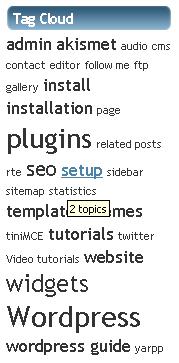How to show Tag Cloud on a wordpress blog
“A tag cloud or word cloud (or weighted list in visual design) is a visual depiction of user-generated tags, or simply the word content of a site, typically used to describe the content of web sites. Tags are usually single words and are normally listed alphabetically, and the importance of a tag is shown with font size or color. “
This is the definition of tag cloud from wikipedia. Tag clouds are usefull for a blog navigation. Tag clouds are replacing ta lists. The power of tag clouds comes from the ability to highlight most used tags. 
Altough wikipedia says that it built to show to visitors what a site or blog is about, i think the main advantage is for navigation. For example you go to a website where you see on the homepage posts about notebooks, netbooks, tablets and phones and other miscelaneous technology related articles. Well, you are interested in tablets only, well, you go to the tagcloud and choose tablets. Or you are interested only in posts about ipad, you select ipad from there and you will get only ipad posts.
WordPress have a separate page for every tag defined by the article authors that appear in search results higher than single post pages. Why ? Because they have more information about a subject, they have the keyword in URL, the keyword in title, in h1 tag, everywhere. So, when you write a post, make sure you select tags wisely.
To add a tag cloud to your blog, go to Appearance -> widgets and drag and drop “Tag Cloud” widget to the sidebar. If wordpress says you don’t have any sidebar defined means your theme is a little messed up. Instead of trying to fix it, the best way is to manually add tag cloud directly to the template file.
In your sidebar.php file, or in the place where you want to add tag cloud, paste the following code:
Disclosure: Some of the links in this post are "affiliate links." This means if you click on the link and purchase the item, I will receive an affiliate commission
February 19th, 2010 at 12:03 pm
[…] The good aspect of tags is that you can display them in different ways. You show tags under an article, you can have a menu list with most used tags on your blog, but the best way that i recommend is to use a tag cloud. […]
December 1st, 2010 at 6:55 pm
[…] You have links for editing posts, adding, view tags, edit […]
December 5th, 2010 at 1:38 pm
Does your tag pages hurt SEO? I heard on other websites that you shoud place nofollow on tag and category pages
December 6th, 2010 at 3:16 pm
Tag pages are ok, are good for relationship between articles and for a good link building structure. Search engine robots can make difference between a tag page and an article page.
There are 2 cases: If you show only summary of posts on the front page, summary will be shown on the tag pages too, so don’t worry about duplicate content.
In the second scenario when you show full posts on the front page you have to make sure that you don’t overuse tags and you won’t have too many tags associated with a single article.
Nofollow is not something i reccomend you to do, if you use tags wisely they will help your articles a lot for natural SEO.
December 15th, 2010 at 4:44 pm
Lucian you mean to say google treats both the links differently one which is linked within the post and another that comes out by Tag link result?
December 15th, 2010 at 7:20 pm
If you link your tag pages from your homepage ( show the tag cloud or popular tags on your sidebar or somewhere else ), they will gain more value for google, they will be considered important pages in your blog. The link juice from the tag pages will flow back to your articles, and giving more power because they are link from more important pages on your blog.
February 22nd, 2011 at 6:27 pm
Links inside the content are always more powerful than sidebar links.
June 2nd, 2011 at 5:26 pm
Lucian,useful article thanks. Is it posible to have a word cloud that is an alphabetical list of the titles of WP pages (city names), but alter the font size dependent on the number of visits to each page, in the same vein as a tag cloud highlights the number of tags in a WP blog. eg, Brighton, Chester, LONDON, Manchester, YORK. ???
June 11th, 2011 at 7:34 am
It is possible, but you need some little programming. You should copy the template tag code from wordpress core functions, rename it and then put it into your functions.php in your theme. Then some little programming into it may give you the best results.